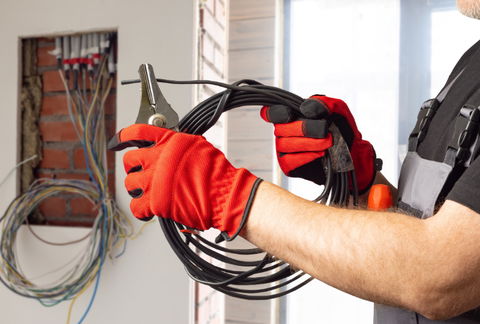When specifying cables for commercial or civil installations, especially those subject to fire safety requirements, it's vital to understand the differences between various descriptions often applied to cable performance, such as LSF (Low Smoke and Fume) and LS0H (Low Smoke Zero Halogen) / LSHF (Low Smoke Halogen Free).

While the terms are often used interchangeably on site or in supplier catalogs, they refer to distinct cable performance types with critical safety implications.
Let’s clarify this distinction to ensure appropriate, safe and compliant cable selection where the Construction Products Regulation (CPR) is referred to.
What Is LSF?
Cables described as LSF are typically made using PVC-based compounds modified to reduce smoke emission, compared to standard grade PVC. These cables may carry labels like "low smoke and fume" or similar marketing terms. However, they are not halogen-free. This means:
Halogens such as chlorine are still present, and
In the event of fire, corrosive and toxic gases (e.g. hydrogen chloride) will still be released.
This can be particularly hazardous in enclosed spaces such as tunnels, hospitals, or high-rise buildings, where toxic gas inhalation and corrosion of emergency systems (e.g., fire alarms, sprinklers) are serious concerns.
Important: LSF is not a formally defined or regulated classification. Its meaning varies between manufacturers and jurisdictions. A cable labeled “LSF” may not meet any European fire performance standards.
What Is LS0H / LSHF?
LS0H / LSHF cables, also referred to as halogen-free or sometimes Low Fire-Hazard (LFH), are designed to address critical fire-related hazards:
Halogen-free materials are used, eliminating release of acidic gases.
Very low smoke emission, preserving visibility in evacuation routes.
Non-corrosive combustion products, protecting sensitive equipment and aiding firefighter access.
These cables are often specified to be tested to harmonised European standards, including:
EN 60754-2 for acidity and conductivity (acid gas emission),
EN 50399, EN 61034-2 and EN 60332-1-2 for flame spread and smoke production.
Under the CPR (EN 50575), cables having these performances typically carry CPR classifications such as Dca-s1b, d1, a1 or higher, indicating strong performance in flame spread, smoke density, flaming droplets, and acidity.
Such cables are widely recommended — often mandated depending on the territory or application — for use in:
Escape routes,
High-density public buildings,
Transport infrastructure,
Sensitive electronic environments.
The Critical Distinction: LSF ≠ LS0H / LSHF
Feature | LSF | LS0H / LSHF |
|---|---|---|
What You Should Do as a Specifier or Installer?
Always check the CPR classification: in Europe, a cable’s fire performance must be certified and CE-marked under CPR (Regulation 305/2011).
Don’t rely on vague terms like “LSF”: Unless backed by documentation and CPR rating, LSF may be inadequate or even misleading.
Specify LS0H / LSHF for safety-critical installations: Use LS0H / LSHF cables with proven classifications—ideally B2ca or Cca with s1, d1, a1 ratings—for schools, hospitals, airports, and any site where evacuation or equipment integrity is a concern.
Verify documentation: Always check the Declaration of Performance (DoP) and CPR label for confirmation. Manufacturers and suppliers must provide this with any CE-marked cable under CPR.
Conclusion
In the electrical profession clarity in specification is critical, especially when fire safety is involved.
The term LSF is not equivalent to LS0H / LSHF, and should not be considered a halogen-free solution.
For higher protection and regulatory compliance, LS0H (Low Smoke Zero Halogen) / LSHF (Low Smoke Halogen Free) cables are able to meet the higher fire performance classifications under EN 50575 and CPR.
As a professional, your responsibility extends beyond conductivity and current-carrying capacity. By ensuring the correct classification and installation of LS0H / LSHF cables, you contribute to safer buildings, reliable systems, and saved lives.
